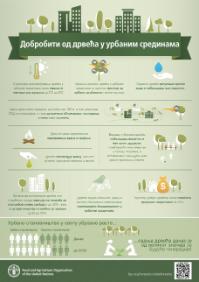Focal point
Location
The Food and Agriculture Organization of the United Nations leads international efforts to defeat hunger. Serving both developed and developing countries, FAO acts as a neutral forum where all nations meet as equals to negotiate agreements and debate policy. FAO is also a source of knowledge and information. We help developing countries and countries in transition modernize and improve agriculture, forestry and fisheries practices and ensure good nutrition for all. Since our founding in 1945, we have focused special attention on developing rural areas, home to 70 percent of the world's poor and hungry people.
Members:
Resources
Displaying 571 - 575 of 5074Course: SDG Indicator 6.4.2 - Level of water stress
This course provides tools, methods and processes to support countries in monitoring and reporting on SDG Indicator 6.4.2 “Level of water stress: freshwater
withdrawal in percentage of available freshwater resources“.Добробити од дрвећа у урбаним срединама
Крошње великог дрвећа у урбаним срединама су одличан филтер за урбане загађиваче и фине честице. Једно дрво може годишње да упије и до 150 кг угљен-диоксида (CO2) из атмосфере, и тиме допринесе ублажавању последица климатских промена. Дрвеће пружа станиште, храну и заштиту биљкама и животињама, повећавајући биодиверзитет у урбаним срединама. Cадња дрвећа данас је од великог значаја за будуће генерације!
Добробити од дрвећа у урбаним срединама
Крошње великог дрвећа у урбаним срединама су одличан филтер за урбане загађиваче и фине честице. Једно дрво може годишње да упије и до 150 кг угљен-диоксида (CO2) из атмосфере, и тиме допринесе ублажавању последица климатских промена. Дрвеће пружа станиште, храну и заштиту биљкама и животињама, повећавајући биодиверзитет у урбаним срединама. Cадња дрвећа данас је од великог значаја за будуће генерације!
State of the forest sector in Central African Republic (2016)
The Central African Republic (CAR) has a total land area of 623,000 km2 of which close to 23 million hectares, i.e. 37%, is composed of forested lands. In the southwestern part of the country all forest operations are industrial. At present there are 11 logging companies, with an average annual production of close to 400,000 m3. Exports of logs and sawn timber are, respectively, close to 160,000 m3 and 40,000 m3. The timber sector accounts for 11% of the GDP and 13% of the country’s export earnings. The main destinations of CAR timber are Europe (47%) and Asia (49%).










